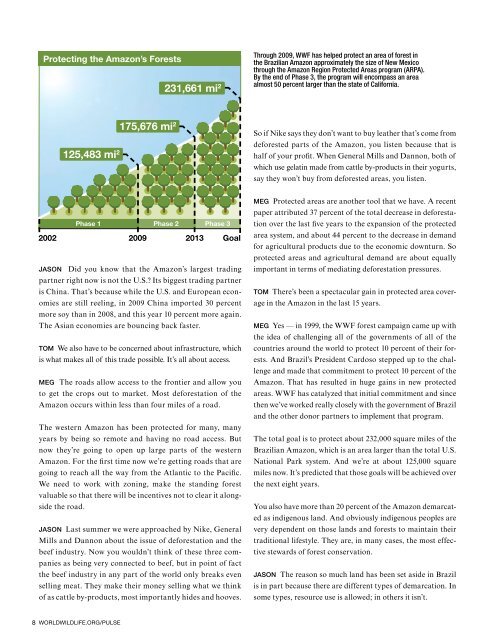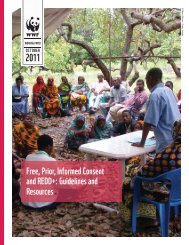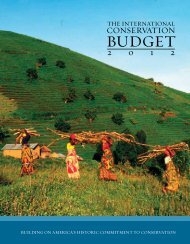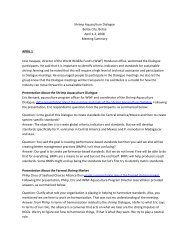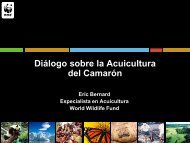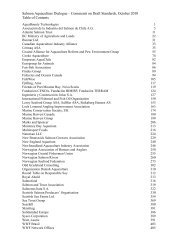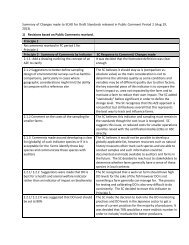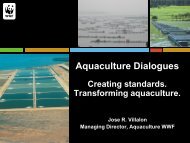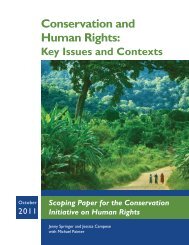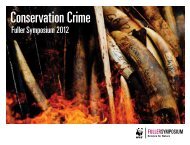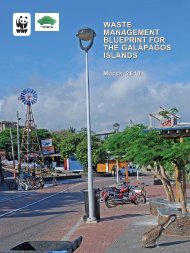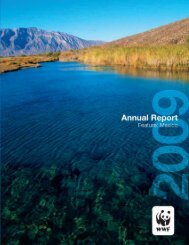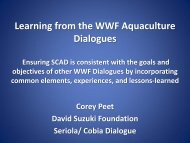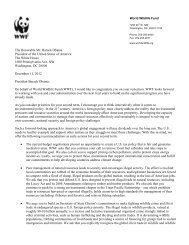Amazon - World Wildlife Fund
Amazon - World Wildlife Fund
Amazon - World Wildlife Fund
Create successful ePaper yourself
Turn your PDF publications into a flip-book with our unique Google optimized e-Paper software.
Protecting the <strong>Amazon</strong>’s Forests<br />
231,661 mi 2<br />
Through 2009, WWF has helped protect an area of forest in<br />
the Brazilian <strong>Amazon</strong> approximately the size of New Mexico<br />
through the <strong>Amazon</strong> Region Protected Areas program (ARPA).<br />
By the end of Phase 3, the program will encompass an area<br />
almost 50 percent larger than the state of California.<br />
125,483 mi 2 175,676 mi 2<br />
So if Nike says they don’t want to buy leather that’s come from<br />
deforested parts of the <strong>Amazon</strong>, you listen because that is<br />
half of your profit. When General Mills and Dannon, both of<br />
which use gelatin made from cattle by-products in their yogurts,<br />
say they won’t buy from deforested areas, you listen.<br />
MEG Protected areas are another tool that we have. A recent<br />
paper attributed 37 percent of the total decrease in deforestation<br />
over the last five years to the expansion of the protected<br />
area system, and about 44 percent to the decrease in demand<br />
for agricultural products due to the economic downturn. So<br />
protected areas and agricultural demand are about equally<br />
important in terms of mediating deforestation pressures.<br />
Phase 1 Phase 2 Phase 3<br />
2002 2009 2013 Goal<br />
JASON Did you know that the <strong>Amazon</strong>’s largest trading<br />
partner right now is not the U.S.? Its biggest trading partner<br />
is China. That’s because while the U.S. and European econ-<br />
TOM There’s been a spectacular gain in protected area coverage<br />
in the <strong>Amazon</strong> in the last 15 years.<br />
omies are still reeling, in 2009 China imported 30 percent<br />
more soy than in 2008, and this year 10 percent more again.<br />
The Asian economies are bouncing back faster.<br />
MEG Yes — in 1999, the WWF forest campaign came up with<br />
the idea of challenging all of the governments of all of the<br />
countries around the world to protect 10 percent of their forests.<br />
And Brazil’s President Cardoso stepped up to the challenge<br />
and made that commitment to protect 10 percent of the<br />
<strong>Amazon</strong>. That has resulted in huge gains in new protected<br />
areas. WWF has catalyzed that initial commitment and since<br />
then we’ve worked really closely with the government of Brazil<br />
and the other donor partners to implement that program.<br />
Children on the way to school in the morning in the Brazilian <strong>Amazon</strong>. There are more than 30 million people living in the <strong>Amazon</strong>, including more than 220<br />
indigenous groups. By promoting the local management of indigenous territories, WWF supports indigenous peoples’ rights and traditional lifestyles and<br />
ensures the long-term conservation of important ecosystems.<br />
© BRAsil2<br />
TOM We also have to be concerned about infrastructure, which<br />
is what makes all of this trade possible. It’s all about access.<br />
Those nuances, coupled with science that says where you need<br />
parks from a diversity point of view and from a connectivity<br />
point of view, have made it a lot easier politically to get these<br />
new areas accepted than simply saying we want to put a fence<br />
around the <strong>Amazon</strong>. Science has played a role. As we’ve understood<br />
better what needs to be protected, we have been able<br />
to make a better case for why it should be protected. There’s<br />
a good moral there.<br />
MEG WWF is just developing its strategy in terms of what<br />
we want to focus on with redd in the <strong>Amazon</strong>. But one really<br />
strong emphasis of our work is building the capacity of governments<br />
to do what they need to do in terms of monitoring<br />
deforestation, setting a national baseline, and being able to<br />
report on that.<br />
MEG The roads allow access to the frontier and allow you<br />
to get the crops out to market. Most deforestation of the<br />
<strong>Amazon</strong> occurs within less than four miles of a road.<br />
The western <strong>Amazon</strong> has been protected for many, many<br />
years by being so remote and having no road access. But<br />
now they’re going to open up large parts of the western<br />
<strong>Amazon</strong>. For the first time now we’re getting roads that are<br />
going to reach all the way from the Atlantic to the Pacific.<br />
We need to work with zoning, make the standing forest<br />
valuable so that there will be incentives not to clear it alongside<br />
the road.<br />
The total goal is to protect about 232,000 square miles of the<br />
Brazilian <strong>Amazon</strong>, which is an area larger than the total U.S.<br />
National Park system. And we’re at about 125,000 square<br />
miles now. It’s predicted that those goals will be achieved over<br />
the next eight years.<br />
We’re also doing a lot in terms of capacity building with<br />
indigenous peoples, trying to increase their ability to engage<br />
in the international negotiations on redd. And we’re trying<br />
to inform and educate ourselves by doing some pilot<br />
projects on the ground, where we try to actually find an area<br />
that’s under threat of deforestation, protect it, quantify the<br />
carbon saved, and then market and sell those carbon credits.<br />
MEG Another way we can make a significant impact is with<br />
redd (Reducing Emissions from Deforestation and Forest<br />
Degradation). This is a component of the negotiations to be<br />
included in the next phase of the global climate treaty. redd<br />
is basically the idea that governments would be compensated<br />
for decreasing their emissions from deforestation and forest<br />
degradation. It’s a very, very complex topic but one that has<br />
great promise for the <strong>Amazon</strong>.<br />
You also have more than 20 percent of the <strong>Amazon</strong> demarcated<br />
as indigenous land. And obviously indigenous peoples are<br />
very dependent on those lands and forests to maintain their<br />
traditional lifestyle. They are, in many cases, the most effective<br />
stewards of forest conservation.<br />
JASON Last summer we were approached by Nike, General<br />
Mills and Dannon about the issue of deforestation and the<br />
beef industry. Now you wouldn’t think of these three companies<br />
as being very connected to beef, but in point of fact<br />
the beef industry in any part of the world only breaks even<br />
selling meat. They make their money selling what we think<br />
of as cattle by-products, most importantly hides and hooves.<br />
TOM We’ve got so much going on in the way of emissions.<br />
And yes, it can get complicated. But you don’t have to have<br />
a perfect system in order to make it work. Most things in human<br />
affairs are operated with error bars anyway.<br />
TOM It’s an idea that’s been around for a long time. It springs<br />
directly from what we were talking about earlier, about the<br />
amount of carbon and the degradation of ecosystems adding<br />
to the atmosphere.<br />
JASON The reason so much land has been set aside in Brazil<br />
is in part because there are different types of demarcation. In<br />
some types, resource use is allowed; in others it isn’t.<br />
redd is essential for going forward. We’ve just got to do it.<br />
8 worlDWildliFE.ORG/pulse Pulse: The hEART of consERvATion 9


